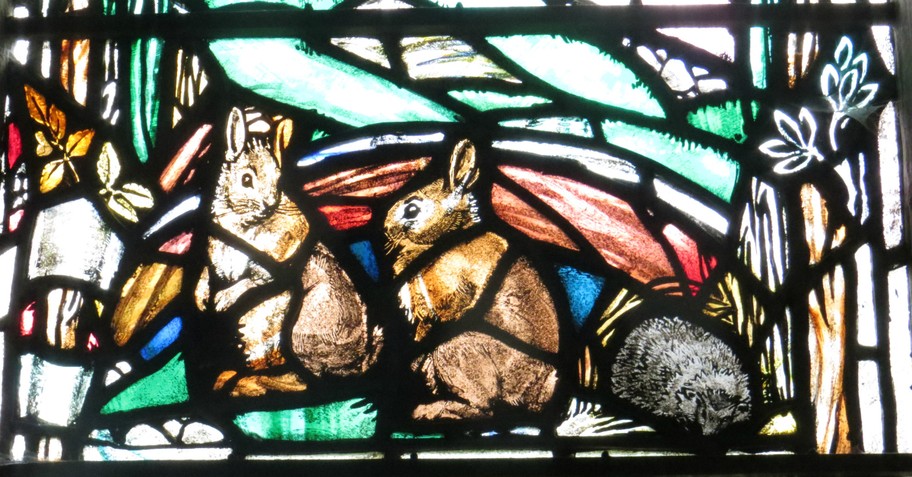The Easter Bunny's Origin and Connection to Christianity

As a Christian, you may have wondered: how in the world did the Easter story of Jesus’ resurrection and the empty tomb (John 20:1-18) ever translate into a bunny that delivers eggs to backyards? Where did this Easter symbolism even come from? What on earth do rabbits have to do with the resurrection story?
Hailing as far back as the Anglo-Saxon period, the idea of the Easter Bunny evolved from a pagan deity to a rabbit that leaves treats for all the good boys and girls.
So, is the Easter Bunny a secular attempt to distract people from the true meaning of Easter? Or are there Christian symbols embedded in this weird twist on the holiday?
Get your FREE Easter Guide here. Have encouragement delivered straight to your inbox!
Photo Credit: ©GettyImages/Konstanttin

When and Where Did the Easter Bunny Tradition Begin?
Believe it or not, the Easter Bunny isn’t the only odd tradition that takes place during Easter season. On the Saturday before Easter, residents of Greece will throw pots out the window, and on Easter Monday boys in Poland will attempt to get people wet by throwing buckets of water on them.
The Easter Bunny origin, however, can likely be traced back to the pre-Christian Anglo-Saxon era where pagans would worship a deity that took the form of a rabbit: Eostre.
Known as the goddess of springtime or dawn, Eostre (or sometimes seen as Eostra or Eastre) is associated with rabbits, pastels, and springtime celebrations.
In other cultures, such as Ancient Rome and even prior, rabbits were associated with rebirth and new life. Because of this, people would include rabbits on their gravestones.
So how did the Christian holiday get wrapped up in this?
Similar to Christmas and Halloween, Christians attempted to blend elements of pagan religion with Christian tradition, in order to make the message of Christianity more palpable to those of other religions.
So, when a group of monks in the late fourth century went to convert the Anglo-Saxons to Christianity, they mixed together elements of the pagan holiday with their Christian calendar.
As far as the bunny who brings children candy, we see that tradition coming to America through German immigrants. Similar to Halloween, the tradition evolved more into candy-themed festivities for children.
Concerning Easter eggs, cultures throughout history have viewed fertility and bringing of life through eggs. Many statues of fertility goddesses, such as statues of Ishtar from Babylon, are often covered in eggs.
Dyed eggs were likely consumed at spring festivals, which explains why some people dip dye eggs on Easter. It’s reasonable that Christians would’ve seen this egg imagery equated with a symbol of life and incorporated eggs into a holiday celebrating eternal life.
Photo Credit: ©GettyImages/leekris

What Does the Easter Bunny Have to Do with Jesus?
Strictly speaking, the Easter Bunny doesn’t directly have much to do with Jesus. Nowhere in the Bible do we see a rabbit of any sort appear in the Easter narrative, and we don’t really see any rabbit imagery in general in the Bible, besides the fact that the Jews were forbidden to eat them due to their unclean nature (Leviticus 11:6).
We have to understand that even though the origins of the Easter Bunny are a bit shrouded in mystery, it most likely does have pagan roots with Eostre, the goddess.
Knowing that rabbits don’t signify Jesus, however, doesn’t prevent us from being able to find ways to observe Christian truths within symbols that are not Christian.
After all, as mentioned before in articles on holidays that Christians have weaved biblical truths into, we’ll look at the example of Paul in Athens. There in the capital of Greece, he encounters a statue to an unknown god. The Grecians, trying to cover all their bases (Acts 17:23), decided to erect this to pay homage to a god they didn’t know or understand, just in case.
Paul uses this pagan symbol as a way to point them to Christ. He tells them about the God they do not know and creates a Gospel presentation from that.
In the same way, with holidays that have pagan origins or traditions (such as Christmas, Halloween, and Easter) Christians have found ways to make the Gospel understandable to cultures through using their symbols and traditions.
Photo Credit: ©GettyImages/Jules Kitano9

How Does the Easter Bunny or Eggs Relate to Resurrection and New Life?
Because the Easter Bunny is likely crafted after the pagan goddess of springtime, and eggs have a historical tie with the symbol of new life, we can easily transfer those symbols to the idea of the new life that comes through Christ (2 Corinthians 5:17).
Also, rabbits are known for multiplying. We can see how the idea of the Great Commission can be applied to rabbits. We are to go and make disciples of all nations (Matthew 28:16-20).
Many churches will often fill plastic Easter eggs with symbols of the Crucifixion and resurrection story (instead of candy) to remind kids about the reason for the Easter season. Some examples of these egg contents may be:
- A donkey (or a drawing of a donkey) to symbolize Jesus’ triumphal entry into Jerusalem (Matthew 21:1-11)
- A purple cloth to represent the “robe” they placed on Jesus, mocking him at his crucifixion
- Nails to represent the nails that pierced Jesus’ hands and feet on the cross (Mark 15:24-26)
- An empty egg to represent the empty tomb of Jesus on the third day, when he rose again (Luke 24)
Here are some more examples of symbols churches may place inside an Easter egg for a Sunday school lesson or children’s sermon.
Photo Credit: ©GettyImages/articgoneape

Why Do Christians Still Celebrate the Easter Bunny?
If the Easter Bunny technically has a pagan origin, why do Christians still celebrate it and also have Easter egg hunts at church?
First, we can see the Easter bunny and Easter egg as an outreach program to the local community. Similar to trunk-or-treat on Halloween, a tradition that allows kids to come in costume at churches and receive candy in a safer environment, churches can invite children of the local community to participate in an Easter egg hunt at the church.
Second, we can know that God can use anything to bring others to him, and this includes originally pagan symbols such as the Easter bunny.
Like Paul speaking about the statue to the unknown God, Christians can use the Easter bunny to bring a Gospel message out of a well-known cultural image.
Third, we can repurpose certain symbols like the Easter eggs to showcase a Gospel message. Instead of candy (although, we can still have Easter egg hunts with candy as a method of outreach), we can have symbols such as the donkey, cloth, nails, etc. to present the message of Jesus’ death and resurrection in a tangible and memorable way.
Finally, Christians can’t always operate in a bubble. Even if we cower away from the Easter bunny, from Christmas trees, from anything that has an origin that isn’t strictly from the Bible, we can’t completely isolate ourselves, or we’ll lose our effectiveness (Matthew 5:13). As mentioned in this article, we use loads of items each day (cars, cell phones, etc.) that the Bible doesn’t say anything about.
Nevertheless, we can use these items as vessels to show others Christ and bring others to him.
Photo Credit: ©GettyImages/colimachon
Originally published February 15, 2024.








